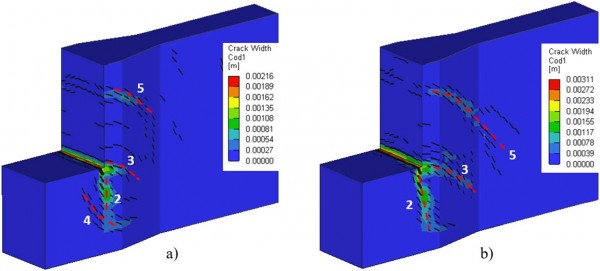기술자료 ATENA Durability enhancement of half-joints in RC bridges through external p…
페이지 정보

본문
Durability enhancement of half-joints in RC bridges through
external prestressed tendons: The Musmeci Bridge’s case study
Giuseppe Santarsiero *, Valentina Picciano
School of Engineering, University of Basilicata, Viale dell’ateneo lucano 10, 85100 Potenza, Italy
A R T I C L E I N F O
Keywords:
RC bridge
Half-joints
Finite element
External post-tension
Durability analysis
Chloride corrosion
A B S T R A C T
This paper numerically investigates the effect of post-tension interventions to strengthen the
deteriorated half-joints of the Musmeci Bridge in Potenza (Italy), with the primary objective of
increasing the ultimate load-bearing capacity and monitoring the secondary effects in terms of
preventing or limiting cracking patterns. Bearing this in mind, the study aims to investigate the
role of the reinforcement detailing, of the post-tension stress and of the corroding time in the
presence of chlorides, outlining the intervention ability to improve the structure’s durability. To
this end, nonlinear finite element models are provided with chloride ions diffusion analysis to
investigate corrosion initiation and progress in reinforced concrete elements and account for
deterioration due to two scenarios (45 and 95 years). Results show the significant impact of
reinforcement layout as the presence of inclined bars increases the ultimate load by about 86 %.
The ultimate load improvement is in the range 50–55 % when the intervention is carried out after
45 years while it is equal to about 30–35 % if a period of 95 years is last since the construction.
This latter highlights the significant influence of the intervention timeliness on structural
durability.
1. Introduction
Old bridges have suffered a significant increase in traffic loads as well as in their frequency which determines heavier loading
conditions compared to design assumptions. Moreover, environmental stresses (e.g., carbonation chloride ingress, freeze-thaw cycles,
etc.) caused material deterioration which was accelerated by the lack of ordinary maintenance interventions. The joint effect of
material degradation and increased loading conditions is represented by a reduction of durability (i.e., the ability to accomplish their
intended purposes for a sufficiently long period, or at least during the expected service life). Huge efforts are needed from the financial
point of view to intervene on many bridges constructed after the Second World War using innovative prestressing techniques even
though with shallow material properties’ control [1]. Therefore, to optimise the use of financial resources for maintaining bridges,
effective technical solutions need to be experimentally tested and numerically verified.
Specifically, cantilever bridges were widely used in the past due to their intrinsic advantages linked to the stress distribution
coupled with their statically determinate condition. Key components of these bridges are half-joints, where cantilever and suspended
spans are connected [2]. These latter are frequently subjected to maintenance issues caused by the water seepage permitted by the deck
drainage malfunction leading the platform water to flow through the expansion joints [3], which are frequently in service after losing
their waterproof feature. Moreover, in harsh climates, platform water contains de-icing salts responsible for chloride ingress and
첨부파일
-
31-CSCM_Musmeci Post-tension.pdf (8.4M)
1회 다운로드 | DATE : 2023-02-13 17:12:41
- 이전글Components for Modeling Steel Connections in RFEM 6 - Connecting Plate 24.01.03
- 다음글Evaluating the effects of loading protocol on the strength and deformation capacity of Flexure-Shear critical concrete columns 23.02.13
댓글목록
등록된 댓글이 없습니다.

